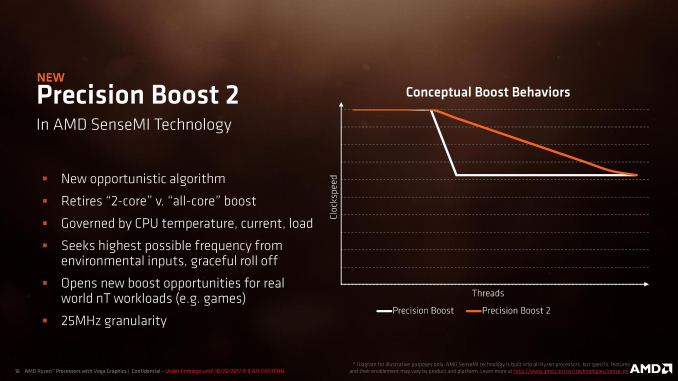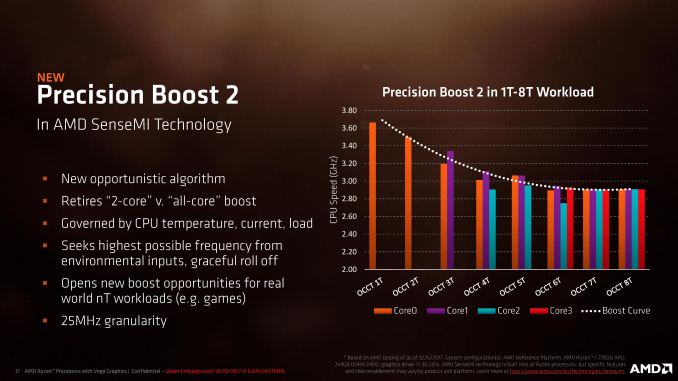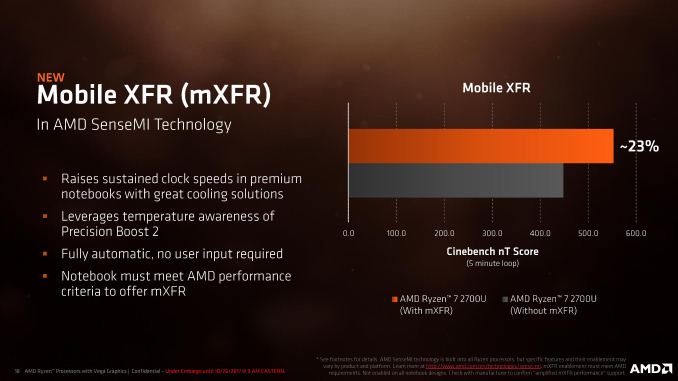Ryzen Mobile is Launched: AMD APUs for Laptops, with Vega and Updated Zen
by Ian Cutress on October 26, 2017 9:00 AM ESTSense Me Ryzen: Better Boost
When AMD launched the desktop Zen processors, it also branded a series of five technologies under the ‘SenseMI’ name. We covered these in detail in our Ryzen 7 review, but in short, it covers the following:
- Pure Power: Sensors to optimize power consumption
- Precision Boost: Determines how Turbo is applied
- Extreme Frequency Range: Going above maximum turbo when possible
- Neural Net Prediction: Using Neural Nets for prefetching data
- Smart Prefetch: Algorithms that work to enhance prefetch
With Ryzen Mobile, the features relating to frequency get an updated model, while Pure Power gets a bigger boost. We’ll cover the power changes on the next page, but it is worth talking about how AMD has improved Precision Boost and brought XFR to laptops.
Precision Boost 2
Most CPU turbo algorithms work by sensing how many cores and threads are under load, determining if the CPU has enough power headroom, and applying a voltage. This is why in the past both of the major x86 CPU manufacturers will quote a ‘per-core turbo frequency’ to show what the frequency should be when different numbers of cores are loaded and all else is fine (there is temperature/power headroom).
For Ryzen Mobile, AMD is pivoting to a new turbo model. When the system is in the P0 (top) turbo state, the system will use a new opportunistic turbo algorithm that rather than being based on the cores under load, is governed by CPU temperatures, currents, and how much load is being applied. The algorithm takes into account all the environmental inputs, such as skin temperature sensors and battery life, and will provide the best turbo frequency it can, regardless of if one thread is being used or all threads are being used.
It will be able to provide boost amounts at the 25 MHz granularity level, similar to how the desktop processors work, with the idea being that in most cases, if the system has a lot of cores available and a background process performs some very light work (such as checking for updates), rather than dropping 500-800 MHz because more cores are loaded, the system will keep at the high frequency.
AMD is stating that this has a big effect on real-world workloads, typically those that have variable thread workloads such as gaming.
When asked if Precision Boost 2 would be coming to the next generation of AMD’s Desktop Ryzen processors, I was told that ‘it could be inferred / it’s a safe bet’.
Mobile Extended Frequency Range (mXFR)
Because mobile systems are thermally limited, battery limited, power limited, and battery limited, offering ‘extra’ turbo headroom is not really something that processor manufacturers like to do. As a result, most of the Ryzen Mobile-powered notebooks will not have any form of XFR – AMD will be allowing it on a case-by-case basis for vendors that overengineer their chassis to be capable of supporting a higher power profile.
This feature essentially extends the average level at which Precision Boost 2 will operate, and also marks what could be considered a higher configurable TDP. One of the systems being launched with Ryzen Mobile this side of Christmas will be mXFR enabled, because the chassis is designed for 25W rather than 15W. It is worth noting that AMD states the configurable TDP of the Ryzen Mobile chips goes up to 25W, so this is likely the case what is happening.
Encode and Decode
AMD is fully using Vega’s encode and decode capabilities with Ryzen Mobile. The big inclusion for AMD’s mobile devices is the ability to decode VP9, the codec prefered in particular by YouTube.
| AMD Ryzen Mobile Encode/Decode Capabilities | |||||
| Decode 1080p @ 4:2:0 |
Decode 2160p @ 4:2:0 |
Encode 1080p |
Encode 1440p |
Encode 2160p |
|
| MPEG2 | 60 FPS | - | |||
| VC1 | 60 FPS | - | |||
| VP9 8/10 bpc | 240 FPS | 60 FPS | |||
| H.264 8 bpc | 240 FPS | 60 FPS | 120 FPS | 60 FPS | 30 FPS |
| H.264 10 bpc | 240 FPS | 60 FPS | |||
| HEVC 8bpc | 240 FPS | 60 FPS | 120 FPS | 60 FPS | 30 FPS |
| HEVC 10 bpc | 240 FPS | 60 FPS | |||
| JPEC 8bpc | 240 FPS | 60 FPS | |||













140 Comments
View All Comments
Rocket321 - Thursday, October 26, 2017 - link
If you can dodge a wrench, you can dodge a ball.MrCommunistGen - Thursday, October 26, 2017 - link
Hahahaha! I was thinking along the same lines:"Remember the 5 D's of dodgeball: Dodge, duck, dip, dive and dodge."
when I read:
"Because mobile systems are thermally limited, battery limited, power limited, and battery limited"
WaltC - Thursday, October 26, 2017 - link
Good for AMD! Last quarter was merely the prelude--in the next few quarters when mobile Ryzen hits its production stride and is fully optimized, along with the Integrated Vega gpu, AMD is going to begin breaking all kinds of records. With the dedicated Ryzen/Vega teams at AMD looking ahead to Ryzen 2 for the desktop--AMD will keep the "pedal to the metal" concerning IPC improvements, die shrinks and all the rest of it. What they won't do is what the old management teams at AMD did, which was to break records and zoom out far ahead of Intel's best (the original Pentium architecture at the time)--only to stupidly *sit on it* after that and hang out a shingle in the nutty idea that it might take Intel a decade to catch them...;) That won't be happening ever again, thanks to Su and the rest of the magnificent design and development teams! Thanks, AMD--nothing smells as sweet to me as the renewed and real competition in the x86 cpu marketplace! Make Intel earn every penny from now on!zodiacfml - Friday, October 27, 2017 - link
They are now finally on par with Intel's 2015 part, Broadwell but using a quad core. I fear that the mobile Ryzen 3 are dual cores.AMD will become even closer once they get to 7nm putting them at the same playing field as Intel
spdragoo - Monday, October 30, 2017 - link
We'll have to wait & see. However, since it seems like their R5 2500U (4C/8T) is a mobile counterpart to their desktop R5 1500X (also 4C/8T), with a lower base clock but similar Turbo clock, I would suspect that the mobile R3 is going to be a 4C/4T CPU. In fact, I wouldn't be surprised if a) they call it the Ryzen 3 2300U (to keep with the naming convention) & b) it comes with the same clocks as the 2500U (maybe less L3 cache, but I doubt it).What should be interesting is seeing how these compare to Intel's Kaby Lake-refresh, low-power CPUs, like the i5-8250U/8350U or i7-8550U/8650U. Except for a Skylake-H i5 & a Skylake-H i7, those were the first true quad-core mobile CPUs with that low of a TDP (& those 2 had a 25W TDP instead of the 15W the Kaby Lakes & these Ryzens have)...
del42sa - Thursday, October 26, 2017 - link
Manufacturing process ???SaturnusDK - Thursday, October 26, 2017 - link
It says 14nm in the very first info box on the first pageFinestar - Thursday, October 26, 2017 - link
Im glad that Acer is included in this. They are my brand. https://www.finestar.com/twtech - Thursday, October 26, 2017 - link
That Envy X360 looks nice - except for the presence of that number pad, which makes it an automatic do-not-buy.SomeCodeJunkie - Thursday, October 26, 2017 - link
Type-O in your chart.Quad-Core with SMT
2.0 GHz Base
3.8 GHz Turbo <- Turbo on the 2500U is 3.6 GHz